A Comprehensive Guide: How to Create a Telegram Bot?
Since its creation in 2013, Telegram has grown in popularity significantly. Its user base has also grown slowly and steadily over the recent years. Today, it has nearly 700 million active users all across the globe. With so many people using this widely utilized messaging platform, Telegram bots have become common. These bots tend to help people be productive, have fun, and connect with their favorite brands through this messenger every day.
Read this comprehensive guide to help you create a Telegram bot without coding.
- Part 1: Understanding the Basics of Telegram Bots
- Part 2: Setting Up Your Telegram Bot Development Tools
- Part 3: A Step-by-Step Guide to Creating Your First Telegram Bot
- Part 4: How to Customize and Add Commands to Your Telegram Bot
- Part 5: Explore Additional Tools for Building Your Telegram Bot
- Part 6: FAQs (Frequently Asked Questions)
Part 1: Understanding the Basics of Telegram Bots
Bots are commonly used for automating different tasks, which means they can run without any specific instructions given by humans. An individual or an organization can utilize a bot to replace a repetitive task that a human would otherwise have to perform. Bots are also way faster at this as compared to humans.
A Telegram bot specifically is a program that provides automation and functions that users can integrate into their channels, chats, or groups. These can be set up by Telegram’s own bot builders or through the Telegram bot API.
Exemplary use cases for Telegram bots include automated newsletters, pushing content to Telegram, real-time info, customer service support, FAQs, file management, translations, and virtual storefronts.

Part 2: Setting Up Your Telegram Bot Development Tools
Telegram welcomes all developers to use its API and source code to create Telegram-like messaging applications on its platform, free of charge. For a user to begin designing a developer app in Telegram, he/she must have an active phone number with an active Telegram account.
After establishing a Telegram account, the following needs to be done to obtain an API ID and develop one's own application using the Telegram API.
- Sign up for Telegram using any application.
- Log in to your Telegram core by using this link.
- Go to the ‘API development tools’ and then complete the form.
- You will get the basic addresses and the api_id and api_hash parameters, which are required for authorization of the users.
- For the moment, each number can only obtain one api_id, which will be connected to it.


Botfather here can be of great help. It is a Telegram bot that manages all the bots that you create through your Telegram account.
You can reach this bot by searching @BotFather on Telegram. To see what this bot can do, send /help or /start in the chat. A list of commands shall appear, which he can do.
Part 3: A Step-by-Step Guide to Creating Your First Telegram Bot
Telegram is one of the most popular instant messaging platforms today, allowing users to store messaging on the cloud rather than only on their devices. It also has great multi-platform support.
Building a chatbot on Telegram is quite a simple process and needs a few steps that take very little time to complete. These chatbots can be integrated into Telegram channels and groups and can also work on their own.
Here is a step-by-step guide to help you create your first Telegram bot:
- Step 1.Set up your bot on Telegram with the help of BotFather
- In order to create a chatbot on Telegram, you need to get in touch with BotFather, a bot used for making other bots.

- Tap the Start button and the command that you will need to use is /newbot. Your bot needs to have a name and a username, from which the name will show up for your bot, and the username shall be used for sharing and mentions.

- After choosing your bot’s name and username, you will receive a message with your access token. You will be required to save this token as well as the username for later.

- Step 2.Choose the right programming language and relevant bot libraries
- In order to begin creating a virtual environment for your bot, you need to choose the right programming language to make the process smooth. There are various options available, including Python, JavaScript, Ruby, PHP, C++, and many more.
- Once you have chosen the programming language, you would need to select relevant bot libraries, depending on your requirements.
- Step 3.Basic code writing for helping your bot function
- Now is the time to set up a coding environment. Install your chosen bot library using pip. Then, open your preferred code editor and create a .env file for storing your token. After that, run the source .env to read the environment variables from the .env file.
- Step 4.Time to test and deploy your bot
- Here, deploy and test your built bot in real time to check if it needs further editing or new reviews.
Part 4: How to Customize and Add Commands to Your Telegram Bot?
You can customize both your bot and the commands for it with ease. This section will explore the features comprehensively.
Bot Customization
Once you have created your bot on Telegram, you might realize that you need a few changes. No issues at all! Here is how you can customize your Telegram bot:
- To begin editing your bot, connect to BotFather (like you did the first time; search @BotFather) and initiate a conversation.
- Once connected to BotFather, select the bot from the list of bots you have created that you wish to edit.
- After you have selected the right bot, choose the ‘Edit Bot’ option and begin making the required changes.
- Now, you have entered edit mode. You can remove or add features to your bot now. For instance, you can program your bot to send certain alerts, play games, or respond to specific keywords.
- Once you have finished editing, save the changes made. BotFather shall guide you through the entire process of saving changes and updating them.
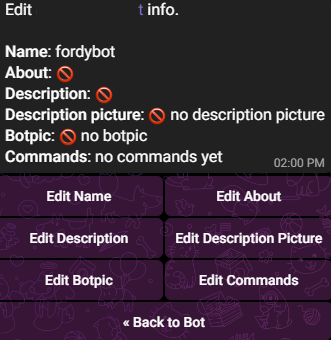
Adding Commands
Bot commands help you improve your bot interaction and its ability to provide users with easy and swift access to the specific features they require.
To create your personal bot commands, decide which commands you wish to use. Then, make them and train your bot to respond to them. The last thing to do is test them to ensure these bots work correctly.
You can add interesting and creative commands such as /weather, /joke, /quote, and /news to train the bot to provide relevant content.
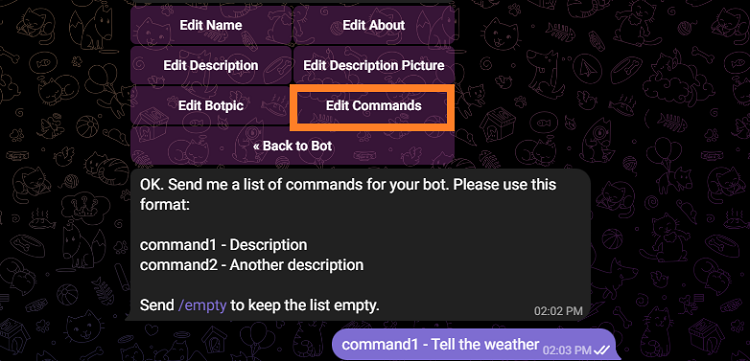
Part 5: Explore Additional Tools for Building Your Telegram Bot
There are other ways of building a Telegram Bot besides BotFather and Telegram’s API. Some of these alternate tools are discussed as follows:
1Chatfuel
Chatfuel is a powerful chatbot builder primarily focusing on versatility and automation. Its main focus is creating bots to manage tasks such as email collection and answering questions. Its chatbot solution ensures that personalized conversations are smooth, allowing the users to engage with their audience in an efficient way. The best part about Chatfuel is that it is effortless to work with.

Pros
- Easy setup process, requires no dev work.
- It has a simple UI and a visual flow builder to let you construct and configure your chatbot.
- Free option which allows you to test before buying in.
- Allows you to create a chatbot that only works on your website.
Cons
- The free version is missing a few key capabilities.
- The templates are to be mixed bag in terms of quality.
2BotPress
BotPress is an open-sourced conversational chatbot platform that allows you to create chatbots for several social networking websites, instant messaging applications, and your own website. With their easy-to-use interface, you can create beautiful chatbots in minutes. And their compliance module ensures that your chatbot meets all the latest regulations.
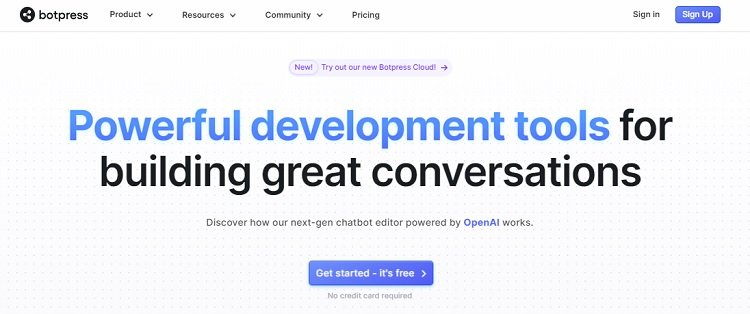
Pros
- Great documentation and easy-to-use.
- Can be customized as per the user’s requirements.
- Powerful language understanding model.
- An excellent Bot framework that can be deployed totally on premise.
Cons
- Dependency on Heroku makes it slow.
- Difficult to run multiple instances from any one installation.
3Pandorabots
Pandorabots is another open-source chatbot framework that allows people to publish and build AI-powered chatbots on the web, mobile applications, and other messaging apps such as Telegram, WhatsApp, Slack, and LINE. Based on Artificial Intelligence Markup Language (AIML), developers can use this platform for building conversational chatbots.

Pros
- Built on AIML scripting language, which is very versatile.
- Open-source platform, letting users own their data and download code.
- Chatbots created can be placed on both message and voice channels.
Cons
- AIML language means users need to define their own I/O pairs.
- Accuracy and reliability of bots created through this framework might be questionable at times.
Telegram Bot Alternative: Create an AI Chatbot with ChatInsight
ChatInsight.AI is a knowledge-based AI chatbot designed to provide users with insightful and detailed responses across a wide range of topics. It leverages advanced AI technologies to analyze and synthesize information, offering comprehensive answers that are both accurate and contextually relevant.
Key features of ChatInsight.AI might include:
- Extensive Knowledge Base: ChatInsight.AI would have access to a vast database of information, encompassing various fields such as science, history, technology, arts, and more.
- Contextual Understanding: The AI would excel in understanding the context of user inquiries, allowing it to provide more relevant and precise answers.
- Natural Language Processing: With advanced NLP capabilities, ChatInsight.AI could understand and respond to queries in a conversational manner, making interactions more intuitive and user-friendly.
- Learning and Adaptation: The AI would continually learn from interactions, enhancing its knowledge base and improving its response accuracy over time.
This AI chatbot would be ideal for educational purposes, research assistance, daily inquiries, and as a general go-to source for reliable information.
Conclusion
Telegrams are remarkably powerful tools for task automation, such as providing relevant information, sending alerts, and even playing games. Businesses and individuals can utilize these bots for automating customer service or other administrative duties. You just need to know how to create a Telegram bot, and you are good to go!
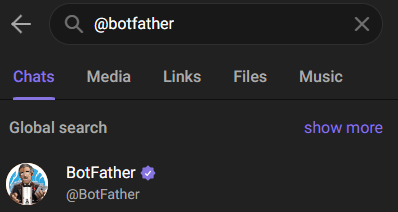
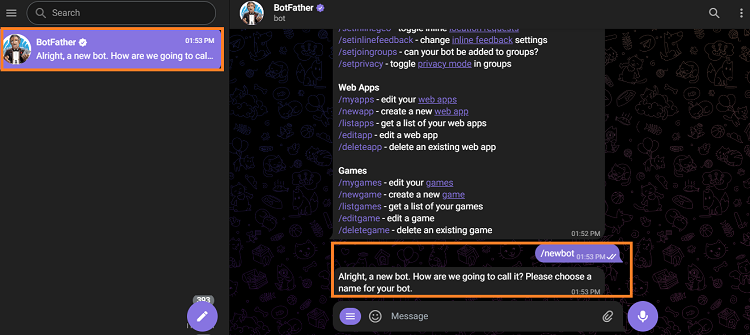
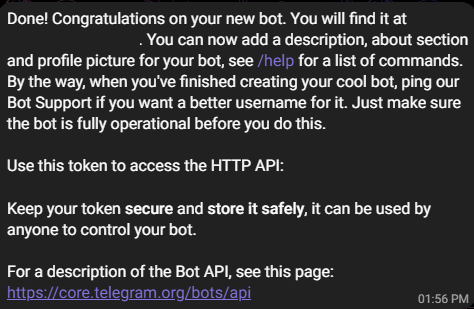



Leave a Reply.